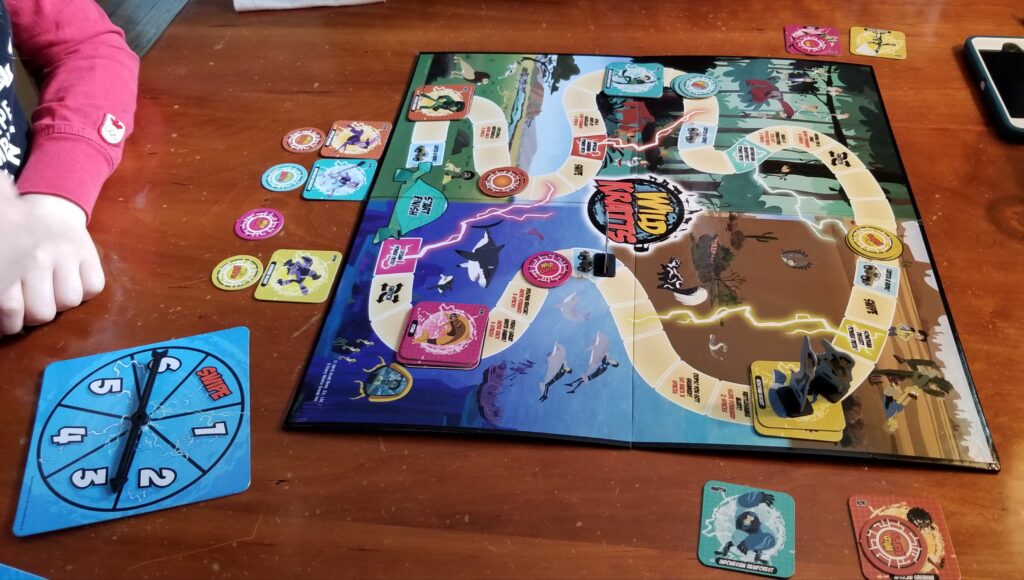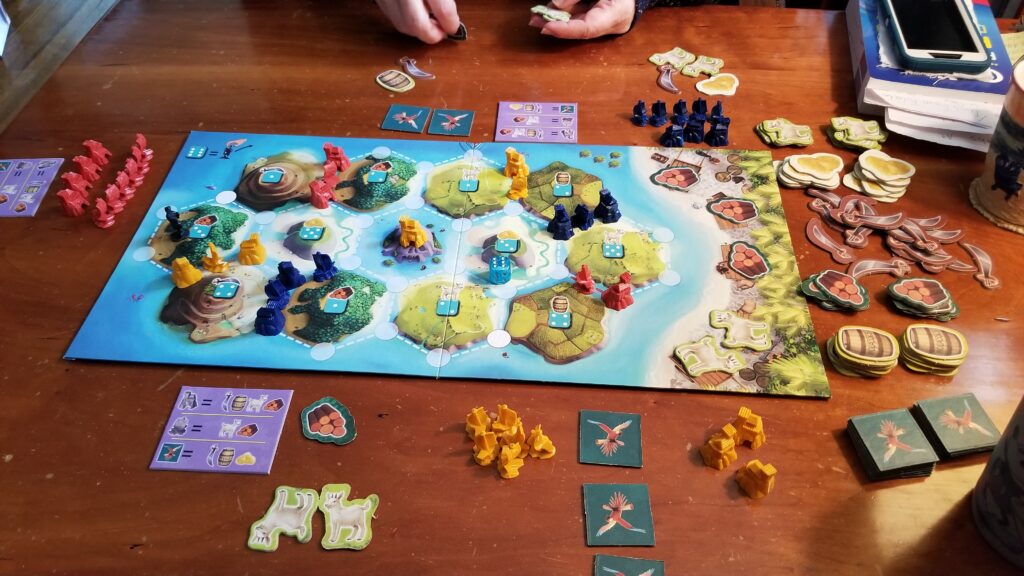
Based on the (excellent) Wild Kratts television show, Race Around The World pits players as some of the show’s characters racing each other through four types of environment.
The show is based on real life animal enthusiast brothers Chris and Martin Kratt, and it spins from them somewhere around the world into a related but fantastical animated story where a team of friends travels the globe to learn about every animal they can. They have amazing technology to use and it’s largely about Chris and Martin’s “power suits”, which are controlled by “power discs” that can each literally transform the brothers into whatever type of animal today’s episode is focused on. Those powers are perfectly suited to outdo whatever nastiness the show’s collection of bad guys have planned for the animal(s) in question.
The game requires characters to get their own power suits and matching power discs from each of the four featured environments as they use a spinner to move around the game’s path. There are fast-forwarding bonuses to pairing suits and discs, and animal-releated advances and setbacks (along with non-animal-related ones) on some of the spaces as you make your way around. There are also animal facts on the backs of each power suit tile, which is a nice touch.
As an added twist that actually involves some strategy (unexpected in a game geared for ages 5+), there are places you can land on where, for example, you determine where else on the path you end up, or will let you grab any power disc you want to, either picking it up from its usual placement on the board or taking it from another player (which forces them to have to get the disc for themselves again). The addition of some actual choices to be made in a game that could otherwise have been a pretty straight-forward zero-thought-involved game is a bonus that continues to help make the game fun, even if overall it’s perhaps getting a bit young for our intrepid tabletop gamer daughter.
It would’ve been nice to see them include Jimmy (one of the five good guy team members, oddly missing from the game) and maybe add a die-rolling or card-drawing aspect that included setbacks or obstacles added by some of the bad guys in the show. That would definitely add to its complexity and thus raise the bottom end of their players’ suggested age, though, which may be why that wasn’t used. Perhaps that could be for another game release. Or perhaps they hadn’t considered it and could use and avid game player/aspiring game designer to pitch them something like that.
Hey Kratt Brothers: Drop me a line. Seriously.
No, seriously.
Wild Kratts Race Around The World is definitely something that young fans of Wild Kratts will enjoy being able to play, and that even us aging fans can have some fun playing. Grab it if you get the chance.

Among the ridiculously popular Catan series games is Catan Junior.
In the original game, players lay out an “island” of connected hexagonal tiles with resources on them and build up their own connected settlements which produce those resources as players take turns rolling dice. Different combinations of the resources are then used to build roads and more settlements, then settlements into cities (which produce even more resources), etc.
The Junior version of the game simplifies a later expansion of Catan where players also build boat routes to other islands to discover what resources they offer. Here the islands and their resources all start off the game revealed and the players–playing pirates, because kids are down with pirates–roll for resources that they get based on where they have, and then build, pirate lairs.
There’s decision-making to be done to figure out which resources you have and trade what you can spare (via a few options) to get what combinations you need in order to build up your ships and lair count. And for older Catan players wondering what happened to the robber/pirate ne’er-do-wells from the regular versions of the games–figures moved by the players on certain rolls, that take resources from players, prevent more from being produced, and the pirate prevents players developing shipping lanes–here there’s also a one-in-six chance that you’ll roll the die and have to move the Ghost Captain, which earns extra resources for the player who moves it and also prevents the island it’s placed on from producing resources for anyone with a lair on it.
So even at this simplified, kid-friendly version of the game, there’s still a touch of the Screw Your Neighbour angle of the original game series. But then, in what better setting than a pirate game would one expect to find cutthroat tactics?
The first player to build their seventh lair (“laiarrrrrrrrrr”?) is the winner, and it’s usually a pretty close game.
*I’ll note that Monopoly Jr. was also played today by my wife and daughter while I was working on some writing contest entries, but since I wasn’t a part of that game it seemed inappropriate for me to include it with overviews of games as I play them.